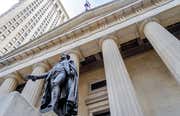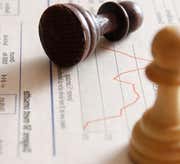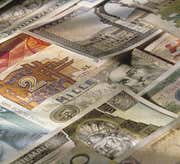Six primary factors influence options pricing: the underlying price, strike price, time until expiration, volatility, interest rates and dividends.
 |
| Figure 2: Six factors that influence option pricing are shown on the top row of the chart. As indicated, the underlying price and strike price determine the intrinsic value; the time until expiration and volatility determine the probability of a profitable move; the interest rates determine the cost of money; and dividends can cause an adjustment to share price. |
Underlying Price
The most influential factor on an option premium is the current market price of the underlying asset. In general, as the price of the underlying increases, call prices increase and put prices decrease. Conversely, as the price of the underlying decreases, call prices decrease and put prices increase.
| If underlying prices ... | Call prices will ... | Put prices will ... |
| Increase | Increase | Decrease |
| Decrease | Decrease | Increase |
Strike Price
The strike price determines if the option has any intrinsic value. Remember, intrinsic value is the difference between the strike price of the option and the current price of the underlying asset. The premium typically increases as the option becomes further in-the-money (where the strike price becomes more favorable in relation to the current underlying price). The premium generally decreases as the option becomes more out-of-the-money (when the strike price is less favorable in relation to the underlying security).
| Premiums increase as options become further in-the-money. |
Time Until Expiration
The longer an option has until expiration, the greater the chance it will end up in-the-money (profitable). As expiration approaches, the option's time value decreases. As a general rule, an option loses one-third of its time value during the first half of its life, and two-thirds of its value during the second half. The underlying asset's volatility is a factor in time value: If the underlying is highly volatile, you can reasonably expect a greater degree of price movement before expiration. The opposite holds true where the underlying exhibits low volatility: The time value will be lower if the underlying price is not expected to move much.
| The longer the time until expiration, the higher the option price. |
| The shorter the time until expiration, the lower the option price. |
Expected Volatility
Volatility is the degree to which price moves, whether it goes up or down. It is a measure of the speed and magnitude of the underlying's price changes. Historical volatility refers to the actual price changes that have been observed over a specified time period. Options traders can evaluate historical volatility to determine possible volatility in the future. Implied volatility, on the other hand, is a forecast of future volatility and acts as an indicator of the current market sentiment. While implied volatility can be difficult to quantify, option premiums are generally higher if the underlying exhibits higher volatility because it will have higher expected price fluctuations.
| The greater the expected volatility, the higher the option value. |
Interest Rates
Interest rates and dividends have small, but measurable, effects on option prices. In general, as interest rates rise, call premiums increase and put premiums decrease. This is because of the costs associated with owning the underlying: The purchase incurs either interest expense (if the money is borrowed) or lost interest income (if existing funds are used to purchase the shares). In either case, the buyer will have interest costs.
| If interest rates ... | Call prices will ... | Put prices will ... |
| Rise | Increase | Decrease |
| Fall | Decrease | Increase |
Dividends
Dividends can affect option prices because the underlying stock's price typically drops by the amount of any cash dividend on the ex-dividend date. As a result, if the underlying's dividend increases, call prices will decrease and put prices will increase. Conversely, if the underlying's dividend decreases, call prices will increase and put prices will decrease.
| If dividends ... | Call prices will ... | Put prices will ... |
| Rise | Decrease | Increase |
| Fall | Increase | Decrease |
Options Pricing: Distinguishing Between Option Premiums and Theoretical Value
-
 Trading
TradingThe Anatomy of Options
Find out how you can use the "Greeks" to guide your options trading strategy and help balance your portfolio. -
 Trading
TradingOptions Strategies for Your Portfolio to Make Money Regularly
Discover the option-writing strategies that can deliver consistent income, including the use of put options instead of limit orders, and maximizing premiums. -
 Trading
TradingThe Basics Of Option Price
Learn how options are priced, what causes changes in the price, and pitfalls to avoid when trading options. -
 Trading
TradingUnderstanding The Options Premium
The price of an option, otherwise known as the premium, has two basic components: intrinsic value and time value. -
 Trading
TradingWhat Is Option Moneyness?
In the money, at the money and out of the money define the current profitability of options positions. -
 Trading
TradingThe Importance of Time Value in Options Trading
Move beyond simply buying calls and puts, and learn how to turn time-value decay into potential profits.



